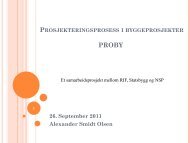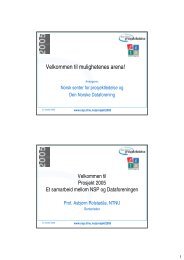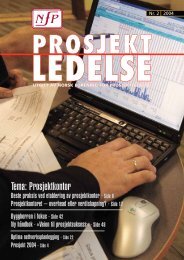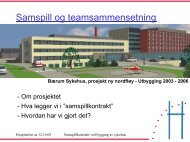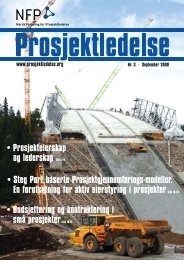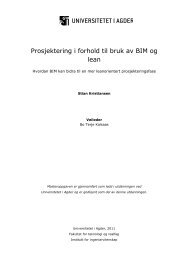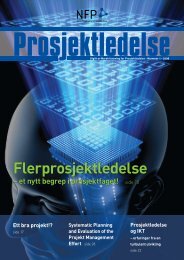Download PDF - NTNU
Download PDF - NTNU
Download PDF - NTNU
You also want an ePaper? Increase the reach of your titles
YUMPU automatically turns print PDFs into web optimized ePapers that Google loves.
22 nd IPMA World Congress“Project Management to Run”9 - 11 November 2008, Roma, ItalyPractical uncertainty management in two railway projects:Tales About Pleasing Our Neighbours but Displeasing Our Most Important FriendsHans Petter Krane 1(PhD Candidate, Norwegian University of Science and Technology (<strong>NTNU</strong>), Trondheim,Norway)AbstractThis paper reports a study of how uncertainty management was performed in two projects by the NorwegianNational Rail Authority, Jernbaneverket (JBV). Particularly, I examine how internal and external stakeholdersinfluenced the projects with respect to delivered functionality, based on interviews with 21 people representing bothinternal and external stakeholders and studies of project documentation. The projects actively managed relationswith external stakeholders, effectively reducing risk of negative media attention and disputes with neighbours andthe cost and time overruns that may follow from such disputes. The focus in both projects, particular in case 2, hasbeen on risk reductions with respect to costs and on time schedules, and less on the interests of internal JBVstakeholders and the functionality delivered by the project. Finally, uncertainty management in the two projectsprimarily concerned risks, and relatively little attention was paid to opportunity management.KeywordsUncertainty management, Project management, Project ownership, Stakeholders1. IntroductionUncertainty management is about handling both positive and negative uncertainty – both risks and possibilities.Traditionally, uncertainty management in projects has been far more concerned about risks than opportunities andmore about costs than benefits (Ward and Chapman, 2003, Jaafari, 2001, Olsson, 2007). Uncertainty exists in allprojects and impacts their outcome. In order to minimize risks and realize opportunities, projects need to manageuncertainty.The stakeholder dimension is often important in uncertainty management. An opportunity for one stakeholder mightbe a threat for another. Olander & Landin (2005) showed how failing to understand and manage externalstakeholders can dramatically delay railway infrastructure projects, and surveys show that coping with externalstakeholders is perceive as imperative to project success (Karlsen, 1998). However, these studies focus on externalstakeholders. Understanding and managing how internal stakeholders within the organisation impact a project maybe as important.For projects where the project output will be handed over to operations on completion, the relation between projectteam and line organisation can strongly influence the uncertainty of a project and be crucial to project successCooke-Davies (2002). A project can only deliver products and services through which it can enable the operationsorganisation to realize the potential benefits of the project. Ensuring good cooperation between project andoperations management should be management’s responsibility (Cooke-Davies, 2002).In this paper, I explore how practical uncertainty management was performed in two infrastructure projects in Jernbaneverket(JBV), the Norwegian National Rail Authority. In particular, I examine how the projects and the line1 Hans Petter Krane, IPK, Valgrinda, <strong>NTNU</strong>, NO-7491 Trondheim, Norwayhans.p.krane@ntnu.no, mobile + 47 975 15 809
22 nd IPMA World Congress“Project Management to Run”9 - 11 November 2008, Roma, Italyorganisation in JBV worked together and how internal and external stakeholders influenced the projects with respectto delivered functionality. The study focuses on uncertainty management of the benefits or ‘delivered functionality’from the projects, and not on uncertainty management of project costs or time scheduling.2. MethodThis paper is based on qualitative case studies of one small (45 M€)railway infrastructure project carried out by JBV between 2000 and 2007 (size limits are adopted from Odeck(2004)). Within JBV, the organisational unit JBV Infrastructure Construction (‘JBV Utbygging’) is responsible forinfrastructure construction. Being mainly a project organisation – it manages and partly also mans the projects. Thisproject organisation is carrying out the projects on behalf of the regional units of JBV, who will have allresponsibility for the infrastructure.Case 1 is a station renewal project with a cost estimate of 3 M€ (base estimate); the first stage of a total renewal ofthe station. The project studied in case 1 includes construction of a new platform and better station access, and wascarried out between autumn 2006 and summer 2007. The station is situated 12 km from Oslo Central Station, and isone of Norway’s larges stations, serving more than 1 million passengers per year.The project in case 2 is a 10 km long section of a planned larger new double track line starting 7 km from OsloCentral Station. The project was built between primo 2001 and August 2005 and had a cost of approximately 450M€. The project also included the rebuilding of two larger stations.This paper is based on interviews with 21 people with relations to the two projects. Seven of these were only relatedto the large project (project owner and management, future user/infrastructure operation, local news media,communication manager and airport shuttle operator). Four were only related to the small project (project owner andmanagement and neighbours (housing association)). Ten had relations to both projects (large train operator, Chief ofJBV Infrastructure Construction, railway inspectorate, head of JBV-internal strategic planning and analysis andpublic transport planning and other key JBV infrastructure management). Studies of project documentation formed abasis for the interviews.3. Results from the studiesJBV was reorganised in the period 2002-2003, something which introduced challenges in both of the studiedprojects concerning ambiguities and uncertainties in the division of roles and responsibilities, particularly between‘JBV Utbygging’ (being the project division of JBV) and ‘Region Øst’ (being the project owner).This is a very brief summary of the larger unforeseen events of the projects. Further comments to the events aregiven in the 'Discussion' section.3.1. Case 1 – Station renewal projectAccording to both interviewees and documentation, important conditions and assumptions changed repeatedly fromstart of detailed planning and throughout the project. In 2005, before start of detailed planning, there were plans tode-prioritise this project in the national budget. Local stakeholders applied political pressure aimed at upholding theoriginal prioritization. In the end, the project was funded, and construction started in 2006.Early increases in cost estimates necessitated a re-evaluation of the project scope. Moreover, The NorwegianRailway Inspectorate (SJT) issued a new set of requirements concerning railway construction shortly after the startof the detailed project planning. These requirements stated that new platforms in curves should only be built wherethe line had a radius of minimum 2000 meters, but the new requirements were not definite and clear. The plannedplatform at this station was to be at a location with line radius of less than 2000 meters. The ambiguity of the newrequirements greatly increased the uncertainty for Jernbaneverket and for the project organisations.JBV Utbygging management interpreted the new requirements strictly and demanded that the new platform was replannedand located in line with these, thereby increasing the risk of cost and time overruns. The project owner, onthe other hand, argued that the requirements were unclear and that there were good reasons for making an
22 nd IPMA World Congress“Project Management to Run”9 - 11 November 2008, Roma, Italyreduction were removed from the project together with new sources for savings, resulting in cost savings totalling150% of the original list (Kalager, 2003). Important cuts include:• Reduced tunnel profile, reducing design speed from 200 km/h to 160 km/h (which will limit the future maxspeed.) This gave a cost reduction of 6.2 M€ (Kalager, 2003)• A planned train turning station was not built. The first plans had prepared for a turning station so that trainroutes could end at a municipal centre without capacity loss at the station serving this centre. The estimatedcost reduction was 4 M€ (Kalager, 2003).• From the plans for the largest station in the project, all heating cables were removed in roofed platforms,stairs and ramps. Hence other solutions were needed to remove ice and snow in winter, which necessitatedfurther changes to platform design and new safety analyses for the public areas. The estimated costreduction was 1 M€, excluding costs of redesign and safety analyses. (Kalager, 2003).Projects changes were to some extent caused by pressure on costs. The ’reduction list’ in case 2 was an example ofthis. Case 1 had no such reduction list, and the design changes necessitated by the new requirements resulted inincreased costs.Interviewees from the JBV line organization felt that the implemented cuts severely reduced the ’functionalitydelivered’, in contrast to what was asserted by the project organisation. From interviewees critical to this decision itwas claimed that the decision seemed irreversible when once made. Even as new consequences occurred, there wasno room for reconsiderations.When the reduction list was first made, a rudimentary assessment was made of how each element would influencethe 'functionality delivered'. There is no evidence suggesting that such influences were reassessed and analyzed inmore detail before the cuts were implemented. At the time the interviews included in this study were carried out, theinternal disputes regarding the functional effects of the reductions had not been resolved. Implementing thereduction list without a reassessment and without settling the resulting disputes increased the uncertainty in theproject. Interviewees from Region Øst pointed out that a conflict often arises between maintaining the functionalitydelivered by a project and keeping within the budget limits. Moreover, they maintained that the life cycle costs ofinfrastructure projects should be considered before implementing changes in projects.Uncertainties regarding signalling systems at the largest station gave large unexpected extra cost. The system thathad first been selected was eventually replaced by a system from a different vendor. The added costs were estimatedto 25 M€ (Kalager, 2003).4. DiscussionNeither nearby residents, environmentalists nor other groups caused any significant problems or delays for either ofthe two studied projects. Friction between the projects and external stakeholders was minimal. Both projects weresuccessful in managing relations with external stakeholders .The findings in this study indicate that the projects, particularly the one in case 2, were less successful in managinginternal stakeholders. The strongest controversies in case 2 seem to have been between the project and Region Øst –future owner of the infrastructure being built. In particular, there were disagreements regarding the project’sdecision to implement the simplifications suggested on the ’reduction list’ and not to install platform heating at thelargest station in case 2. From Region Øst, it was claimed that this reduced the functionality of the infrastructuredelivered by the project. Other stakeholders in JBV, however, maintained that the changes had minimal impact onfunctionality.Mismatches between statements from the different interviewees within JBV regarding the functionality deliveredfrom the project may indicate that cooperation between the project and operations was subject to too little attention,something which may have endangered project success (Cooke-Davies, 2002). Project management, particularly incase 2, didn’t involve the JBV line organisation sufficiently. If future users of the infrastructure dispute that the newinfrastructure will fill its purpose, they may be less likely to utilize it properly, potentially jeopardizing the successof the project.This study indicates that uncertainty management in the two studied projects was primarily concerned with avoidingcosts and time overruns. The projects’ delivered functionality was less in focus. There seemed to be a risk
22 nd IPMA World Congress“Project Management to Run”9 - 11 November 2008, Roma, Italymanagement regime – focusing on avoiding negative risks. Of the two studied projects, the larger was under thestronger pressure with respect to cost and time, potentially limiting focus on delivered functionality even further.For the project organisations studied here the main goal will quite naturally be project success. – i.e. on time projectcompletion delivering the pre-defined quality within the set budget (Samset, 2003 #158). The project ownerorganisations studied here were dominated by future users responsible for maintenance and operation of theinfrastructure, and focused on the functionality of the deliveries of the project. They seemed far less concernedabout project budgets and time schedules. In short, the primary interests of the project and project ownerorganisations differed, as can be expected (Shenhar et al., 2001, Jaafari, 2001, Slevin and Pinto, 1987).5. ConclusionsThe two studied projects have actively managed relations with external stakeholders, effectively reducing risk ofnegative media attention and disputes with neighbours and the cost and time overruns that may follow from suchdisputes. The focus in both projects, particular in Case 2, has been on risk reductions with respect to costs and ontime schedules, and less on the interests of internal JBV stakeholders and the functionality delivered by the project.Finally, uncertainty management in the two projects primarily concerned risks, and relatively little attention waspaid to opportunity management.6. Further workThis paper indicates a need to further develop models and mechanisms for cooperation between project and lineorganisations, particularly with respect to uncertainty management.ReferencesCOOKE-DAVIES, T. (2002) The "real" success factors on projects. International Journal of Project Management,20, 185-190.JAAFARI, A. (2001) Management of risks, uncertainties and opportunities on projects: time for a fundamental shift.International Journal of Project Management, 19, 89-101.KALAGER, A. K. (2003) Notat - Kostnadsbesparende tiltak som er implementert i prosjektet "Nytt dobbeltsporSandvika Asker" ("Memo - Cost reducing measures that have been implemented in the project "Newdouble track Sandvika Asker"" - In Norwegian only).KARLSEN, J. T. (1998) Mestring av omgivelsesusikkerhet : en empirisk studie av prosjekter ("Coping withenvironmental uncertainty: An empirical study of projects", in Norwegian, summary in English). PhDThesis 1998:16. Trondheim, Norwegian University of Science and Technology (<strong>NTNU</strong>).MYDSKE, P. K. (1999) NOU 1999:28. Gardermoprosjektet: evaluering av planlegging og gjennomføring ("TheGardermoen project: Evaluation of the planning and implementation". In Norwegian), Oslo, Statensforvaltningstjeneste, Statens trykning.ODECK, J. (2004) Cost overruns in road construction--what are their sizes and determinants? Transport Policy, 11,43-53.OLANDER, S. & LANDIN, A. (2005) Evaluation of stakeholder influence in the implementation of constructionprojects. International Journal of Project Management, 23, 321-328.OLSSON, R. (2007) In search of opportunity management: Is the risk management process enough? InternationalJournal of Project Management, 25, 745-752.SHENHAR, A. J., DVIR, D., LEVY, O. & MALTZ, A. C. (2001) Project Success: A Multidimensional StrategicConcept. Long Range Planning, 34, 699-725.SLEVIN, P. D. & PINTO, K. J. (1987) Balancing Strategy and Tactics in Project Implementation. Sloanmanagement review, 29, 33.SMEDSTAD, T. (1997) Effective information handling?: an analysis of organizational communication strategiesimplemented by Forsvarets Relokalisering Gardermoen, Gardermobanen A/S and Oslo Lufthavn A/s. Oslo,Universitetet.WARD, S. & CHAPMAN, C. (2003) Transforming project risk management into project uncertainty management.International Journal of Project Management, 21, 97-105.
22 nd IPMA World Congress“Project Management to Run”9 - 11 November 2008, Roma, Italy



